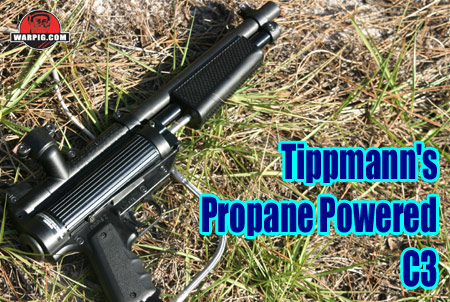  |
|
|
|
|
|
|
  |
|
|
|
|
|
|

What
do you think?
|

Tippmann C3 By Bill Mills - Photos by Dawn Mills - Dec 2005 Overview - How It Works - Disassembly - Testing - Raw Test Data
Testing
The C3 performed as most any pump marker should be expected to perform. While Tippmann lists the maximum rate of fire at 4 balls per second in practical operation 1.5 balls per second was realistically achieved, with one limitation on the rate of fire being the rate at which the ignition circuit will fire. To check velocity stability, as string of 30 shots was fired over a ballistic chronograph. Due to the pumping action required by the C3, these shots were taken manually, rather than under computer control, and fired at approximately 1-second intervals. The string produced a standard deviation of 9.4, with 95% of the shots falling within plus or minus 4.0 of the average velocity.
Lacking both the ability to fire and cycle the pump action C3 under electronic control, and the capacity to compare the stock barrel to the standardized Freak used in most newer WARPIG.com paintgun reviews, the C3 was not put through an automated target shooting cycle. To get an idea of how gas efficient the C3 is, a propane tank was weighed, attached to the C3, fired 200 times, removed and weighed again. The test was designed to simulate real world use, where a player would be shooting about 200 shots in a pump paintball afternoon, and removing the cylinder for storage. The weight difference in the tank indicated the mass of propane consumed both from firing, and from the process of changing the tank for storage. Over 5 trials, 0.1 ounces of propane was consumed per trial. Given 16.4 ounces of propane in a typical disposable tank, this would yield approximately 164 200-shot playing sessions, or a total of 32,800 paintballs fired. It should be noted that these measurements were taken with the factory setting on the propane regulator, and adjusting the regulator to provide the minimum lean mixture needed to reliably reach the desired velocity would further improve gas efficiency, just as mixing the fuel/air mixture overly rich would decrease it.
One comment that was common to many who saw the C3 for the first time at the 2005 PSP Paintball World Cup or NPPL Commander’s Cup was that it was unusually loud. Product demonstration models were available at Tippmann’s trade show trailer, and many players had their chance to dry-fire the C3. It is normal for paintguns to sound louder when dry fired than when loaded with paint.
To find out just how loud the C3 is, it was compared with a Tippmann 98 Custom powered by compressed air. Peak sound level measurements were taken from both paintguns at a distance of five feet from the muzzle, at an angle of approximately 45 degrees from the axis of the aimpoint. At the end of the ten shot strings, the C3’s average peak sound output was 67.4 dB compared to the 98Cs 65.3. While the C3 was slightly louder on average, the smallest sound level change even detectable by the human ear is normally considered to be 1 dB, while some recording professionals say it is really around three. Some of the C3’s quieter shots were softer than some of the loudest from the 98, and vice-versa. Overall the sound difference was not significant. In terms of general on field performance,
the C3 was found most definitely comparable to typical pump action paintguns,
whether powered by CO2 or compressed air.
Because of the rate of fire limitations found in a pump paintgun, the Tippmann
C3 may not appeal so greatly to paintball players at organized fields where
semi-autos rule the roost. The C3 is well suited, however to bring
paintball to new players who don’t live near these fields, but have their
own land where they can safely and legally organize games, but don’t have
access to CO2 or HPA fills.
|
| Copyright © 1992-2019
Corinthian Media Services. WARPIG's webmasters can be reached through our feedback form. All articles and images are copyrighted and may not be redistributed without the written permission of their original creators and Corinthian Media Services. The WARPIG paintball page is a collection of information and pointers to sources from around the internet and other locations. As such, Corinthian Media Services makes no claims to the trustworthiness or reliability of said information. The information contained in, and referenced by WARPIG, should not be used as a substitute for safety information from trained professionals in the paintball industry. |